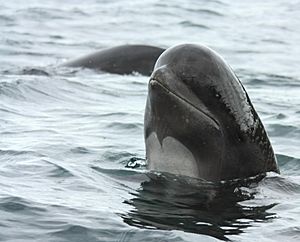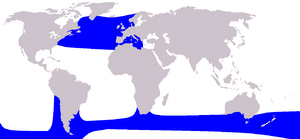Long-finned pilot whale facts for kids
Quick facts for kids Long-finned pilot whale |
|
|---|---|
 |
|
 |
|
| Size compared to an average human | |
| Conservation status | |
| Scientific classification | |
| Subspecies | |
|
Globicephala melas melas |
|
 |
|
| Range of the long-finned pilot whale | |
| Synonyms | |
|
Globicephala melaena |
The long-finned pilot whale (Globicephala melas) is a very large type of oceanic dolphin. It belongs to the same group, Globicephala, as the short-finned pilot whale. These whales are called "long-finned" because their front fins (pectoral fins) are unusually long.
Contents
About the Long-Finned Pilot Whale
Why They Are Called "Pilot Whales"
Pilot whales got their name because people used to think there was a "pilot" or leader in each group. This leader would guide the others.
Their scientific name, "Globicephala", comes from two old words. Globus means "globe" (like a ball) and kephale means "head". This describes their round heads. The word "melas" is Greek for "black". Sometimes, people also call them "pothead whales". This is because their heads look like black cooking pots.
How Scientists Study Pilot Whales
The long-finned pilot whale was first named in 1809 by Thomas Stewart Traill. He called it "Delphinus melas". Later, its scientific name was changed a few times. But in 1986, scientists decided to go back to its original name, "melas".
Long-Finned Pilot Whale Body and Appearance
How Big Do Pilot Whales Get?
Male and female long-finned pilot whales are different sizes. Females can grow up to 5.7 meters (about 18.7 feet) long. They can weigh up to 1,300 kilograms (about 2,866 pounds). Males are much bigger. They can reach 6.7 meters (about 22 feet) long and weigh up to 2,300 kilograms (about 5,070 pounds).
This makes the long-finned pilot whale the second largest dolphin. Only the killer whale (Orcinus orca) is bigger.
What Do Pilot Whales Look Like?
Even though it's called a "whale," the long-finned pilot whale is actually a large type of dolphin. Orcas are also dolphins, not true whales.
Pilot whales have a round, bulbous (bulging) forehead. Their bodies are black or dark grey. They have lighter grey or white marks on their throat and belly. The mark on their throat often looks like an anchor. Some pilot whales also have a light patch behind their dorsal fin. This is called a saddle patch. They might also have a stripe behind their eye.
Their dorsal fin (the fin on their back) is thick and curved. It is located about one-third of the way down their body. Their long, curved pectoral flippers (side fins) are a key feature. These flippers can be 18 to 27 percent of their total body length. Like all toothed whales, they have one blowhole on top of their head.
It can be hard to tell male and female pilot whales apart in the wild. Males are generally bigger. Scientists are still studying other ways to tell them apart. It is also very hard to tell long-finned and short-finned pilot whales apart at sea. Their main differences are the length of their flippers and how many teeth they have.
Pilot Whale Brains
Long-finned pilot whales have a lot of brain cells. They have almost twice as many neocortical neurons as humans. These are important cells for thinking and learning.
Pilot Whale Behavior and Life
How Pilot Whales Live Together
Long-finned pilot whales are very social animals. They usually live in groups. These groups can be small, with just a few whales, or very large, with over a thousand. Most often, groups have 20 to 150 whales.
Studies show that they form small, lasting family groups. These groups usually have about 8-12 whales. Genetic studies suggest that these groups are often made up of related whales. This means that calves, especially females, might stay with their mothers for their whole lives.
Pilot whale groups have been seen interacting with other dolphins. These include common bottlenose dolphins and Atlantic white-sided dolphins.
What Pilot Whales Eat
Pilot whales mainly eat cephalopods, like squid. In some areas, they might eat more fish. For example, whales in the northwestern Atlantic mostly eat short-finned squid.
Pilot Whale Activities
You can often see long-finned pilot whales doing special behaviors. They might lobtail, which is when they slap their tail on the water. They also spyhop, which means they stick their head out of the water to look around. Sometimes, they even breach, jumping partly or fully out of the water.
Why Pilot Whales Strand
This species is known for mass strandings. This is when many whales get stuck on a beach. In New Zealand, many pilot whales beach themselves from December to March. Scientists are not sure why this happens. But because pilot whales have strong social bonds, it is thought that if one whale strands, the rest of the group might follow.
Pilot whales have also been seen "babysitting" calves that are not their own. Some studies show that male whales often do this babysitting.
How Pilot Whales Talk
Long-finned pilot whales make many different sounds. They make squeaks, whistles, and buzzes to talk to each other. They also make fast clicks. These clicks are used for echolocation. Echolocation is like a natural sonar. It helps them "see" in dark or murky water. They listen to the echoes that bounce back from objects.
Their whistles and calls can be heard over a wide range of frequencies. These sounds are often repeated in sequences. They use these repeated calls more when they are socializing with each other.
Pilot Whale Reproduction and Life Cycle
Female pilot whales are ready to have babies at about 8 years old. Males are ready around 12 years old. Mating can happen at any time of year. But it is most common in late spring and early summer. It is thought that whales from different groups meet up to mate.
A female pilot whale is pregnant for about 12 to 16 months. She gives birth every 3 to 6 years. Baby pilot whales are usually 1.6 to 2.0 meters (about 5 to 6.5 feet) long at birth. They weigh about 75 kilograms (about 165 pounds). Most calves are born in the summer. Some male whales may stay with their mothers even after they are grown up.
Where Long-Finned Pilot Whales Live
How Many Pilot Whales Are There?
It is hard to know exactly how many long-finned pilot whales there are worldwide. Scientists think there are many of them. But there are no recent, reliable numbers for the global population. Because of this, their conservation status is "Data Deficient." This means we don't have enough information.
One study estimated about 13,000 whales off Newfoundland, Canada. Another study estimated 780,000 animals in the North Atlantic. But this study included both long-finned and short-finned pilot whales.
Where Pilot Whales Live Today
Long-finned pilot whales live in two main areas. One group lives in the North Atlantic Ocean. The other group lives in the Southern Hemisphere.
In the North Atlantic, they are found in many places. This includes off the coasts of the eastern U.S. and Canada. They are also seen across the Atlantic near the Azores and Faroe Islands. They live down the western coast of Europe, all the way to North Africa.
In the southern ocean, they are usually found between 19°S and 60°S. But they have been seen as far south as 68°S, near sea ice in the Antarctic.
Where Pilot Whales Lived in the Past
There used to be a third group of long-finned pilot whales. They lived in the western North Pacific, near Japan. These whales are thought to have died out between the 8th and 12th centuries. Scientists found fossils of them in Japan. Now, short-finned pilot whales live in parts of this region.
Pilot Whale Strandings
Large Mass Strandings
Long-finned pilot whales are the most common species to be involved in mass strandings. The biggest stranding ever recorded happened in 1918. About 1,000 whales stranded on the Chatham Islands.
Mass strandings of this species happen most often in New Zealand. But pilot whales have also stranded in northern Europe, North America, South America, and parts of Africa.
In 2017, over 600 pilot whales stranded at Farewell Spit, New Zealand. This was the second largest mass stranding ever recorded.
What We Learn from Strandings
Scientists learn important things from mass strandings. Studies show that whales that strand together are not always from the same family. Different family groups can be found in one stranding event.
Protecting Long-Finned Pilot Whales
Current Conservation Status
Some groups of long-finned pilot whales are protected. For example, those in the North Sea and Baltic Sea are listed under a special agreement. This is because they need help to be conserved.
The long-finned pilot whale is also covered by several international agreements. These agreements help protect small whales and dolphins in different parts of the world.
Whaling of Pilot Whales
Whaling of long-finned pilot whales has happened for a long time in the Faroe Islands. This practice is called grindadráp in Faroese. It mainly happens in the summer. These hunts are not for selling the meat commercially. Instead, the meat is shared within the community.
Hunters use many boats to surround the whales. They then guide the whales into a bay or fjord. The hunts are regulated by the Faroe Islands. However, the International Whaling Commission does not control these hunts because they are for small whales.
In 2008, health officials in the Faroe Islands suggested that pilot whale meat might not be safe to eat. This is because of high levels of mercury in the whales.
The Faroe Islands are the only place with large-scale long-finned pilot whale hunts today. But this species was also hunted in other places in the past. In Canada, a large hunt started in Newfoundland in 1947. In 1956, about 10,000 pilot whales were caught and killed there. They were also hunted along the New England coastline in the U.S. A few pilot whales are still caught in Greenland each year.
Whale Watching Tourism

Long-finned pilot whales are important for the whale-watching industry. This is especially true in eastern Canada. Many different whales live in the Gulf of St. Lawrence and around Newfoundland. But pilot whales are often seen close to shore in the summer. Tour boats, often old fishing vessels, take people to see them. Seeing pilot whales helps bring money to small fishing communities.
Scientists are still studying how whale-watching affects long-finned pilot whales.
Museum Specimens
A full skeleton of a long-finned pilot whale is on display at Leeds City Museum in the UK. This whale was found in the Firth of Forth in 1867.
Images for kids
See also
 In Spanish: Calderón común para niños
In Spanish: Calderón común para niños












